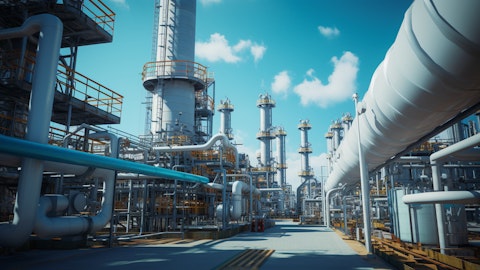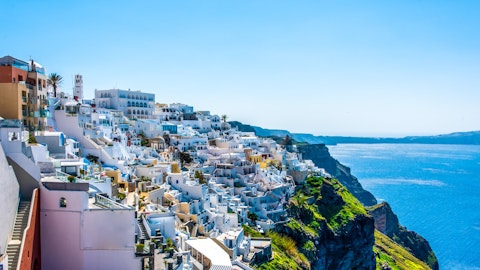Torgrim Reitan: I can take the first one, which is more a technical question related to how we book and how we treat Empire Wind in our books. I mean, it used to be equity accounted because we owned only 50% out of it. So it was only the equity part of our investment that was on our balance sheet and also only part of the – only the equity cash flow in future earnings report. Now we have to consolidate it fully in our books and also have 100% in. So it’s actually a significant change in way sort of it is reported. When the project financing is in place, and we expect that package to be in place late this year, we will still have to report it 100% and consolidate it until we have farm-down to a lower level. So, in insulation, it won’t impact the reported CapEx until we have reduced the ownership share. I hope that answers your question, Biraj. Yes.
Anders Opedal: And if I understood the questions correctly regarding M&A. It was about international business. We have high graded the portfolio there over the last few years, exited several countries. And this actually enables the – together with the project sanction that we have mentioned, that will give the 50% increase in cash flow from 2023 to 2030. We will continue to high grade the portfolio going forward, but we will not comment on any future M&As, either divestment or acquisitions.
Bard Glad Pedersen: Very good. Let’s take the next one from Martijn Rats, Morgan Stanley.
Martijn Rats: Yes. Hi. Hello. I also had two questions, if I may. One relates to Exhibit 30, the one that shows CFFO for 2024, 2025 to 2027 and then the outer period at different price scenarios. And if you look at that exhibit carefully, if we go from 2024 to 2025, 2027, the $55 scenario goes up, the $75 scenario goes up, but the $95 scenario goes down. And I was wondering if there is something in that period that I’m missing. It’s sort of – exhibit implies that the company’s CFFO becomes substantially less oil price sensitive. But I can’t imagine that, that is really the message behind the chart. So slightly more of a technical point perhaps, but I wanted to ask that. The second question I want to ask is somewhat different.
When a company gives sort of guidance over the next sort of five to five years, it’s usually an outcome of the projects that are in front of them and the business that’s going on. But when the guidance becomes much longer sort of like 10, 11, 12 years, it’s often more of a sort of statement of intent of a direction of travel that the company sort of aspires to rather than the business that’s right in front of them. If you look at the DD&A and the capital employed, your entire capital employed will turnover over the next decade. So in a decade from now, there’s a lot of choice still to be made. So I was wondering by 2035, the guidance now implies that somewhere between 75% to 80% of CFFO will still be oil and gas. So I was wondering to what extent that is an outcome of simply the projects that you see to and to what extent it’s sort of like an aspiration, more like an intent to travel in that direction?
Torgrim Reitan: You take the first one which is a technical question, Martijn. And it is actually the tax lag that drives this, the tax lag on the Norwegian continental shelf. So in 2024, you only have half of the tax associated with the $95 million, while the year after, you have 1.5x the tax of the $95 million. So it is a truly technical question, and the answer is a truly technical one, Martijn. So that’s the reason.
Anders Opedal: Okay. So when it comes to the 2025 intent or projection is really based on the project portfolio that we do have in place and all the opportunity sets we do have on the Norwegian continental shelf. So if we take it a little bit first for the EPI, it’s really the three projects that I mentioned, the Bacalhau, the Raia, the Sparta and Rosebank for – sorry. And we also have [indiscernible] as a future project. So the projection there is really based on these reprojects. When it comes to the Norwegian continental shelf, it is the long project list of non-sanctioned projects, more than 30 projects that already – Kjetil, he knows about this project. He’s going to develop them. We’re going to go to guy and say, I want them.
I want them below $35 in breakeven. And also we know from experience that the ILX will give good results going forward. So it’s not only our projection. It’s actually based on actions we’ve already taken. It’s the seismic that Hege alluded to that is already acquired, being interpreted and new targets coming in place. So that’s why we were able to extend this to 2035 this year. At the same time, we also demonstrate and you’ll find it in the appendix, a long list of renewable projects and low carbon solution projects yet to be sanctioned, yet to be find the profitability and for some of these project customers. But then we also balance this with the flexibility in copper. So it is really based on the portfolio that we do have at home.
Bard Glad Pedersen: Let’s take one in the room and then on the line, Paul Redman from BNP Paribas.
Paul Redman: Thank you very much. It’s Paul Redman from BNP Paribas. And I’ve got two questions. The first is just going back to Empire Wind. And follow-on from Biraj’s question, essentially, you’re saying that you can increase return through project financing and farm downs. I wanted to ask what your current view of those markets are at the moment. So in terms of timing, on when you could do those and the CapEx could come down? What are your current expectations? And I see that in – and I think I’m right in your guidance on renewable returns, you’re talking about 12% to 16%, but I don’t think you include Empire Wind in that. I just wanted to confirm that. And then the second one is just you’ve given yourself a bit of flex on the buyback, $10 billion to $12 billion.
What drives the upside on buyback? And when we get to 2025, if you’re at 15% gearing or the lower level of your optimized balance sheet guidance, where would you expect distributions to go after that? Could you see more extraordinary in 2025 plus?
Anders Opedal: Okay. Paul, you can say a little bit about the market as you see it. You are out there every day. And if I understand before – if I understand your question correctly, you talked about the 12% to 16% return on equity for renewables. That is based on, as an example, it’s the Dogger Bank and it’s our solar plants in Europe that we have seen those type of returns. But if you look back for the whole renewable portfolio from 2015 to 2023, we have a double-digit return nominal on our portfolio. Pal, will you?
Pal Eitrheim: Yes. So I’ll leave it to Torgrim to comment on the financing part of it. But on the farm down market, we’re seeing now projects because of the challenges on both sides of the Atlantic, we’re seeing fewer projects on the U.S. East Coast. Empire 1 is by far one of the most mature projects that are available in the sense that it has four years of permitting work behind it. It has all of the main contracts secured with negotiated rates. So we have a fairly good line of sight to what the cost level will be. So I’m quite hopeful that we will be able to find a good partner and that this is an attractive asset also because it is among the few that can develop in a sort of pre-2030 perspective. And I’ll just build a little bit on the answer you gave earlier on this.
But what we faced in last year, we saw that the unprecedented macro and inflation that came, we saw that it was eroding profitability of our portfolio. We have canceled the offtake contract for Empire 2. We have done the swap with BP. So we have effectively reset and high graded that portfolio and we now have line of sight to post economics going forward, provided we can succeed in the New York 4 bid, where we have bid on a level which we think or hope will be competitive, but at the same time, can help restore economics through Empire Wind 1.
Torgrim Reitan: Yes. On your question on project financing or financing package, that is progressing. And this is a big financing package naturally in the U.S. It is complex, but it is progressing well, and we aim to sign, there would be a financial close, not very long after an investment decision. So it will come pretty close to visual. I think it’s very important on your point, Paul, that de-risking this project will create value. And sort of clearly winning and New York Phase 1 is sort of de-risking one level, having a final investment is the second, having a financial package on is a third one. So the more we de-risk, the more buyers there will be and the more attractive prices we can achieve. So that’s the way of thinking around when potentially to create value from that asset.
Anders Opedal: What was the second question?





